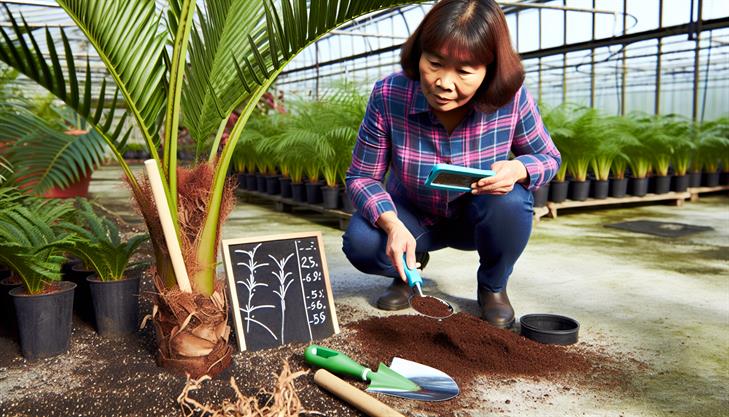Imagine transforming your home or garden into a tropical paradise, filled with lush greenery that effortlessly infuses any space with vitality and a sense of tranquility. Among the most sought-after plants to achieve this dream is the Areca palm, known for its elegant, arching fronds and ability to purify the air. But before you embark on your quest to grow these beautiful palms, you might be wondering: just how fast do Areca palms grow?
This question isn’t just about satisfying your curiosity; it’s key in planning and nurturing your green sanctuary effectively. Fast-growing plants can quickly fill out a space and bring about that desired lush look, while also influencing how you design and maintain your garden or indoor greenery. Understanding the growth rate of Areca palms can help you decide the best planting locations, how often to repot, and what additional care may be necessary to keep them thriving.
In this comprehensive guide, we’ll delve into the growth habits of Areca palms, offering insights into factors that influence their speed, such as environmental conditions and care techniques. By the end of this article, you’ll be equipped with all the knowledge needed to cultivate a thriving Areca palm, ensuring your living space is both breathtaking and healthy. Join us on this journey to uncover the secrets of one of nature’s most graceful creations!
Understanding the Areca Palm Growth Cycle
The Areca Palm, a popular choice for indoor and outdoor decoration, is admired for its lush, feathery foliage. Understanding its growth cycle is key to nurturing a healthy plant, so let’s delve into how fast Areca Palms grow and the factors influencing it.
Growth Rate of Areca Palms
Areca Palms (Dypsis lutescens) have a moderate growth rate, typically reaching a height of about 6 to 10 feet indoors and up to 20 feet outdoors over several years. Generally, they grow approximately 6 to 10 inches per year. The growth rate can vary based on several conditions, so let’s explore these in detail:
1. Light Conditions
Areca Palms thrive in bright, indirect sunlight. Insufficient light can slow their growth, while too much direct sunlight can scorch the leaves. To optimize growth:
- Position your palm near an east or west-facing window if indoors.
- Outdoors, ensure they receive filtered sunlight, perhaps under the shade of taller trees.
2. Watering Needs
Consistent watering is crucial for Areca Palms, as improper watering can hamper growth:
- Water when the top inch of soil feels dry, usually once a week.
- Ensure the pot has good drainage to prevent root rot.
- Reduce watering frequency during the winter months when the plant’s growth slows naturally.
3. Soil and Potting
Areca Palms require well-draining soil to thrive:
- Use a standard potting mix amended with sand or perlite for better drainage.
- Repot every 2-3 years to refresh the soil and accommodate growth.
4. Humidity and Temperature
These palms prefer warm and humid conditions typical of their native climate:
- Aim for temperatures between 65°F to 75°F.
- Increase humidity by misting the plant regularly, using a humidifier, or placing it on a tray with water and pebbles.
5. Fertilization
Fertilization supports quicker and more robust growth:
- Use a balanced, liquid fertilizer diluted to half strength every month during spring and summer.
- Avoid fertilizing in the fall and winter when growth naturally slows.
Common Issues and Troubleshooting
- Yellowing Leaves: Often a sign of overwatering or nutrient deficiency. Ensure proper watering and consider a soil test to check nutrient levels.
- Brown Leaf Tips: Usually indicates low humidity or underwatering. Increase humidity around the plant and review watering practices.
- Pests: Keep an eye out for mealybugs and spider mites, which can inhibit growth. Use insecticidal soap or neem oil as needed.
Additional Tips
- Rotate your Areca Palm occasionally to ensure even growth and light exposure.
- Keep it away from cold drafts, which can stress the plant and stunt growth.
In conclusion, while Areca Palms have a moderate growth rate, facilitating the right environmental conditions can significantly enhance their development. By maintaining appropriate light, temperature, hydration, and nutrition, you can ensure your Areca Palm grows at a healthy pace, adding a vibrant touch to your space.
Essential Tips for Optimal Growth Speed
Areca palms, also known as Dypsis lutescens or butterfly palms, are popular houseplants known for their lush, feathery fronds. If you’re considering adding one to your indoor or outdoor space, understanding how fast areca palms grow is essential for proper care and expectation management.
Growth Rate and Life Cycle
Areca palms typically grow at a moderate rate, which translates to about 6 to 10 inches per year. In optimal conditions, these palms can reach a mature height of 6 to 12 feet indoors and up to 20 feet in outdoor tropical environments. Patience is key, as they may take a few years to reach their full size.
Environmental Conditions Promoting Growth
-
Light Requirements: Areca palms thrive in bright, indirect sunlight. Placing them near an east or west-facing window is ideal. Too much direct sunlight can scorch the leaves, while insufficient light can slow their growth rate. If growing outdoors, ensure they are placed in partial shade.
-
Temperature and Humidity: These palms prefer warm temperatures between 65°F to 75°F (18°C to 24°C) and high humidity levels. Draughts and temperatures below 50°F (10°C) can impede growth and cause damage. Consider using a humidifier or pebble tray to maintain humidity, especially in dry climates.
-
Soil and Potting: Well-draining soil is crucial. Use a palm-specific potting mix or a blend of peat, perlite, and sand. Repotting every 2-3 years into a slightly larger container will help accommodate growth and ensure root health.
Watering and Fertilization
Watering: Areca palms prefer consistently moist soil but are susceptible to root rot if overwatered. Water the plant when the top inch of soil feels dry. In winter, reduce watering frequency as growth slows.
Fertilization: Feed with a balanced, water-soluble fertilizer diluted to half-strength every 2 to 4 weeks during the growing season (spring and summer). Avoid fertilizing in winter when growth naturally slows down.
Common Growth Issues
-
Yellowing Leaves: This may indicate overwatering or poor drainage. Ensure pots have drainage holes and adjust your watering habits.
-
Brown Tips: Often caused by underwatering, low humidity, or mineral buildup. Increase humidity and flush soil with distilled water if using tap water.
-
Pests: Areca palms can attract spider mites and mealybugs. Regularly wipe leaves with a damp cloth and use insecticidal soap if necessary.
Additional Tips
- Pruning and Maintenance: Trim dead or unhealthy fronds close to the trunk to maintain the plant’s appearance and encourage healthy new growth.
- Propagation: Areca palms can be propagated by dividing clumps. Ensure each new division has roots and plant it into a separate pot.
By providing the ideal growing conditions and necessary care, you can manage how fast your areca palms grow while keeping them healthy and vibrant. Whether you’re greening up your home or your garden, these palms will add a lush tropical feel to your space.
Tools and Techniques to Enhance Areca Palm Growth
Areca palms, known scientifically as Dypsis lutescens, are popular indoor and outdoor plants prized for their lush, feathery fronds and their ability to bring a touch of the tropics to any setting. If you’re wondering "how fast do areca palms grow," it’s essential to understand not only their growth rate but also the factors influencing their development.
On average, areca palms can grow between 6 to 10 inches per year when provided with optimal conditions. However, several factors can either accelerate or hinder this process. Here’s a comprehensive guide to help you maximize the growth of your areca palm:
Ideal Conditions for Areca Palm Growth
-
Light Requirements:
Areca palms thrive in bright, indirect light. Direct sunlight can scorch their leaves, while insufficient light slows growth. To encourage a steady growth rate, place your areca palm near a south or west-facing window where it can enjoy filtered sunlight. -
Soil and Potting:
Use well-draining soil rich in organic matter to prevent water stagnation, which can lead to root rot. Ensure your pot has adequate drainage holes. Repotting every two to three years can aid in providing room for the roots to expand, which supports faster growth. -
Watering Techniques:
Consistent moisture is key for areca palms. Water the plant when the top inch of soil feels dry. Typically, this means watering every 10-14 days, more frequently during the growing season (spring and summer) and less during winter. Avoid overwatering, as this can harm root health. -
Temperature and Humidity:
Areca palms prefer warm conditions (around 65-75°F or 18-24°C) and high humidity. Indoor areca palms may benefit from occasional misting or placement near a humidifier, particularly in dry climates or during winter when indoor heating can reduce moisture levels in the air. -
Fertilization:
Monthly feeding with a balanced liquid fertilizer during the growing season can enhance palm growth. Be cautious not to over-fertilize, as this can cause leaf burn and hinder growth.
Troubleshooting Common Growth Issues
- Yellowing Leaves: Often a sign of overwatering or nutrient deficiency. Adjust watering habits and consider supplementing with a micronutrient-rich fertilizer.
- Brown Tips: Commonly caused by dry air, underwatering, or salt build-up from fertilizers. Ensure adequate humidity and evenly distributed watering.
Additional Tips
- Pruning: Regular pruning of yellow or dead fronds not only improves the plant’s appearance but also encourages new growth.
- Pest Control: Areca palms can be susceptible to spider mites. Routinely check for infestations and treat the plant with insecticidal soap if necessary.
By understanding and catering to the specific needs of areca palms, you can significantly improve their growth rate and overall health. Remember, while areca palms might grow slowly, patience and proper care will reward you with a graceful and vibrant plant.
Troubleshooting Slow Growth in Areca Palms
Areca palms are a popular choice for both indoor and outdoor settings, appreciated for their lush, feathery fronds and air-purifying qualities. Understanding the growth pattern of areca palms is essential for those keen on nurturing a healthy plant. On average, areca palms grow at a moderate pace, reaching about 6 to 10 inches per year. Under optimal conditions, they can achieve up to three feet in a single year after they have been established.
Understanding Their Growth Rate:
-
Young Plants: Areca palms grow slower during their initial stages. When they are young and especially when grown from seeds, they might show minimal growth. Patience is key during this period.
-
Established Plants: Once the palm has adapted to its environment and established a solid root system, you can expect more vigorous growth. It’s during this phase, typically after the first year, that areca palms can reach their full growth potential.
Factors Affecting Growth:
-
Light Conditions: Areca palms thrive best in bright, indirect sunlight. Insufficient light can stunt their growth significantly. If you are growing areca palms indoors, placing them near an east or south-facing window can help simulate their natural conditions.
-
Watering Routine: Consistent and appropriate watering is crucial. Overwatering or allowing the soil to completely dry out can cause root problems which impede growth. Aim to keep the soil slightly moist, and ensure proper drainage to prevent waterlogging.
-
Soil Quality: Using well-draining soil is essential. A mixture designed for palms or a general potting mix with added perlite or sand will help avoid compaction and provide the aeration that areca palms need.
-
Temperature and Humidity: Being tropical in nature, areca palms grow best in temperatures between 65°F and 75°F (18°C to 24°C). Moreover, high humidity levels support healthier growth, which can be achieved through regular misting or using a humidifier.
-
Fertilization Practices: Regular feeding during the growing season can enhance the growth rate. Utilize a balanced liquid fertilizer every two months during spring and summer. Avoid fertilizing in fall and winter when the plant’s growth naturally slows down.
Troubleshooting Slow Growth:
-
Inspect for Pests: Areca palms can fall prey to pests like spider mites and mealybugs. Regularly inspect the leaves for any signs of infestation, which can contribute to slow growth. Use insecticidal soap or neem oil for treatment.
-
Check Root Health: If growth is notably sluggish, gently check the root system for signs of rot or damage. Poor root health can significantly hinder the plant’s growth.
-
Analyze Light Levels: Evaluate your lighting conditions, and if necessary, move the plant to a brighter location, but avoid direct harsh sunlight that can scorch the leaves.
-
Adjust Watering: Incorrect watering is a frequent cause of growth issues. Ensure you are watering appropriately, and prevent the extremes of under-watering or overwatering.
By addressing these concerns and maintaining optimal conditions, areca palms can grow into healthy and vibrant plants, adding a tropical touch to your space. Understanding how fast areca palms grow and how to support their growth allows enthusiasts to enjoy their beauty for years to come.
Long-Term Care for Healthy Areca Palms
Areca palms are a popular choice for both indoor and outdoor spaces, appreciated for their lush, tropical appearance. Understanding their growth rate can help in planning for their care and placement. But, how fast do areca palms grow?
Growth Rate Overview
Areca palms typically grow at a moderate rate. Under optimal conditions, they can grow about 6 to 10 inches annually. This growth speed allows them to gradually fill a space with their arching, feathery fronds without overwhelming the area. In outdoor settings in tropical or subtropical climates, they might expand somewhat quicker than indoors due to better light and climate conditions.
Conditions for Optimal Growth
-
Light Requirements: Areca palms thrive in bright, indirect light. Direct sunlight can scorch the leaves, while insufficient light can slow growth. For indoor planting, place them near a window with filtered sunlight or use a sheer curtain to diffuse light.
-
Watering Routine: These palms require regular watering to maintain their growth rate. The soil should be kept consistently moist but never soggy, as too much water can lead to root rot. In the growing season, typically spring and summer, increase watering frequency, and reduce it slightly during fall and winter.
-
Soil and Potting: Well-draining soil is crucial. A mix that includes sand, peat, and loam works well. When potting, ensure the container has drainage holes to prevent water stagnation. Repotting is generally required every couple of years or when you notice roots growing out of the pot.
Common Growth Issues
- Yellowing Leaves: This may indicate overwatering or poor drainage. Check the soil moisture levels and adjust your watering schedule if needed.
- Brown Tips: Often caused by low humidity or underwatering. To combat this, consider using a humidity tray or misting the leaves regularly.
- Stunted Growth: Possible reasons include poor lighting, nutrient deficiencies, or pot-bound roots. Ensure adequate light exposure, and feed your areca palm with a balanced, water-soluble fertilizer during the growing season.
Additional Tips for Healthy Growth
-
Temperature: Areca palms prefer warmer temperatures ranging from 65 to 75 degrees Fahrenheit. Avoid exposing them to drafts or extreme temperature changes.
-
Fertilizing: Feed your palm with a diluted liquid fertilizer every month during growing periods to replenish crucial nutrients and promote robust growth.
-
Pruning: Regularly remove dead or damaged fronds. This not only improves the plant’s appearance but also directs energy towards new growth.
By following these guidelines and maintaining optimal conditions, you can support the steady growth of your areca palms, ensuring they remain a vibrant feature of your space. Whether you’re nurturing them indoors or out, understanding how areca palms grow allows for better long-term care and enjoyment of these elegant plants.
In conclusion, understanding the growth rate of areca palms is essential for both novice and experienced gardeners looking to enhance their indoor or outdoor spaces. Typically, areca palms grow at a moderate pace of up to 6-10 inches per year, depending on various factors such as soil quality, light, and proper maintenance. By ensuring adequate sunlight exposure and maintaining optimal soil conditions, these lush palms can thrive and contribute to a vibrant ambiance.
Consistent watering without over-saturating and providing regular fertilizer during the growing months are crucial steps to fostering a healthy growth environment. Furthermore, proper pruning can encourage fuller growth and provide the aesthetic appeal that many are desiring.
As you apply these insights to your gardening endeavors, remember that patience and consistent care are vital components in nurturing your areca palms. A final tip: consider rotating your pots every few months if your palms are indoors, ensuring even light exposure, which can promote balanced growth. With these strategies in place, your areca palms will flourish, adding elegance and a tropical touch to your home or garden.


